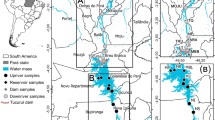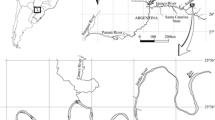Abstract
A confluence zone in the Upper Paraná River Floodplain was sampled to verify the influence of upstream reservoirs on the dispersion and colonisation of phytoplankton. We hypothesized that the dilutive effect and high discharge limit phytoplankton colonisation in the main stem and that the phytoplankton functional structure in floodplain lakes is influenced by upstream reservoirs. The recruitment of functional group (FG) M from Rosana Reservoir was evidenced with low establishment in the main stem and colonisation in the floodplain lake. The lower connectivity with the Paraná River during limnophase reflected in water column total mixing and dominance of the FGs C and P in floodplain lake and greater stability of the water column, with dominance of the FG H 1 in a secondary channel. In the potamophase, the Paraná River negatively influenced the phytoplankton biovolume in the associated environments. In this period, FG P was dominant in the secondary channel and FG X 2 in the floodplain lake. Our results emphasize that despite the contribution of inocula to the Parana River from the upstream inflow and from tributaries, the phytoplankton depletion was due to retention and seston sedimentation in the Porto Primavera Reservoir, high discharge and dilution in this confluence zone.





Similar content being viewed by others
References
Abrahams, C., 2008. Climate change and lakeshore conservation: a model and review of management techniques. Hydrobiologia 613: 33–43.
Benda, L., K. Andras, D. Miller & P. Bigelow, 2004. Confluence effects in rivers: interactions of basin scale, network geometry, and disturbance regimes. Water Resources Research 40: W05402.
Blanchet, F. G., P. Legendre & D. Borcard, 2008. Forward selection of explanatory variables. Ecology 89: 2623–2632.
Borges, P. A. F., S. Train & L. C. Rodrigues, 2008. Estrutura do fitoplâncton, em curto período de tempo, em um braço do reservatório de Rosana (ribeirão do Corvo, Paraná, Brasil). Acta Scientiarum Biological Sciences 30(1): 57–65.
Borges, P. A. F., S. Train, J. D. Dias & C. C. Bonecker, 2010. Effects of fish farming on plankton structure in a Brazilian tropical reservoir. Hydrobiologia 649: 279–291.
Borics, G., G. Várbíró, I. Grigorszky, E. Krasznai, S. Szabó & K. T. Kiss, 2007. A new evaluation technique of potamo-plankton for the assessment of the ecological status of rivers. Archives fur Hydrobiologie Supplement 161(3–4): 465–486.
Bovo-Scomparin, V. M. & S. Train, 2008. Long-term variability of the phytoplankton community in an isolated floodplain lake of the Ivinhema River State Park, Brazil. Hydrobiologia 610: 331–344.
Brown, B. L. & C. M. Swan, 2010. Dendritic network structure constrains metacommunity properties in riverine ecosystems. Journal of Animal Ecology 79: 571–580.
CESP, 1998. Conservação e manejo nos reservatórios: limnologia, ictiologia e pesca. Série Divulgação e Informaçãom, São Paulo: 220.
Cloern, J. E., 2007. Habitat connectivity and ecosystem productivity: implications from a simple model. American Naturalist 169(1): 21–33.
Cole, G. A., 1994. Textbook of Limnology. Waveland Press Inc., Illinois.
Coulon, A., J. F. Cosson, J. M. Angibault, B. Cargnelutti, M. Galan, N. Morellet, E. Petit, S. Aulagnier & J. M. Hewison, 2004. Landscape connectivity influences gene flow in a roe deer population inhabiting a fragmented landscape: an individual-based approach. Molecular Ecology 13: 2841–4850.
C.P.C., 2012. Climate Prediction Center. National Weather Service. Available at: http://www.cpc.noaa.gov.
Devercelli, M., 2010. Changes in phytoplankton morpho-functional groups induced by extreme hydroclimatic events in the Middle Paraná River (Argentina). Hydrobiologia 639: 5–19.
Fonseca, I. A., N. S. Siqueira & L. Rodrigues, 2009. Algas Perifíticas a montante e jusante do local de instalação de tanques-rede em tributários do reservatório de Rosana – Paraná, Brasil. Acta Scientiarum 31(2): 135–141.
Garcia de Emiliani, M. O., 1997. Effects of water level fluctuations on phytoplankton in a river-floodplain lake system (Paraná River, Argentina). Hydrobiologia 357: 1–15.
Giné, M. F., H. Bergamin, E. A. G. Zagatto & B. F. Reis, 1980. Simultaneus determination of nitrite and nitrate by flow injection analysis. Analytica Chimica Acta 114: 191–197.
Golterman, H. L., R. S. Clymo & M. A. M. Ohstad, 1978. Methods for Physical and Chemical Analysis of Freshwater. Blackwell Scientific Publication, Oxford.
Hofmann, H., A. Lorke & F. Peeters, 2008. Temporal scales of water-level fluctuations in lakes and their ecological implications. Hydrobiologia 613: 85–96.
Huszar, V. L. M., C. Kruk & N. Caraco, 2003. Steady-state assemblages of phytoplankton in four temperate lakes (NE U.S.A.). Hydrobiologia 502: 97–109.
Koroleff, K., 1978. Determination of ammonia. In Grasshoff, K. & E. Kremling (eds), Methods of Seawater Analysis. Verlag Chemie, Winhein.
Kruk, C., N. Mazzeo, G. Lacerot & C. S. Reynolds, 2002. Classification schemes for phytoplankton: a local validation of functional approach to the analysis of species temporal replacement. Journal of Plankton Research 24: 901–912.
Legendre, P., J. Oksanen & C. J. F. Ter Braak, 2011. Testing the significance of canonical axes in redundancy analysis. Methods in Ecology and Evolution 2: 269–277.
Leibold, M. A., E. P. Economo & P. Peres-Neto, 2010. Metacommunity phylogenetics: separating the roles of environmental filters and historical biogeography. Ecology Letters 13: 1290–1299.
Leira, M. & M. Cantonati, 2008. Effects of water-level fluctuations on lakes: an annotated bibliography. Hydrobiologia 613: 171–184.
Lund, J. W. G., C. Kipling & E. D. Lecren, 1958. The inverted microscope method of estimating algal number and the statistical basis of estimating by counting. Hydrobiologia 11: 980–985.
Mackereth, F. Y. H., J. R. Heron & J. F. Tailing, 1978. Water analysis: some revised methods for limnologists. Freshwater Biological Association (Scientific Publication No. 36).
Nilsson, C., C. A. Reidy, M. Dynesius & C. Revenca, 2005. Fragmentation and flow regulation of the world’s large river systems. Science 308: 405–408.
O’Farrell, I., R. Sinistro, I. Izaguirre & F. Unrein, 2003. Do steady state assemblages occur in shallow lentic environments from wetlands? Hydrobiologia 502: 197–209.
Padisák, J., L. O. Crossetti & L. Naselli-Flores, 2009. Use and misuse in the application of the phytoplankton functional classification: a critical review with updates. Hydrobiologia 621: 1–19.
R Development Core Team, 2012. R: a Language and Environment for Statistical Computing. R Foundation for Statistical Computing, Vienna, Austria. Available at: http://www.R-project.org/.
Reynolds, C. S., 2000. Hydroecology of river plankton: the role of variability in channel flow. Hydrological Processes 14: 3119–3132.
Reynolds, C. S., V. L. M. Huszar, C. Kruk, L. Naselli-Flores & S. Melo, 2002. Towards a functional classification of the freshwater phytoplankton. Journal of Plankton Research 24: 417–428.
Roberto, M. C., N. F. Santana & S. M. Thomaz, 2009. Limnology in the Upper Paraná River floodplain: large-scale spatial ad temporal patterns, and the influence of reservoirs. Brazilian Journal of Biology 69(2 Suppl): 717–725.
Rodrigues, L. C., S. Train, B. M. Pivato, V. M. Bovo-Scomparin, P. A. F Borges & S. Jati, 2005. Assembléias fitoplanctônicas de 30 Reservatórios do estado do Paraná. In Rodrigues, L., S. M. Thomaz, A. A. Agostinho & L. C. Gomes (eds), Biocenoses em reservatórios: padrões espaciais e temporais. RIMA, São Carlos: 57–72.
Rodrigues, L. C., S. Train, V. M. Bovo-Scomparin, S. Jati, C. C. J. Borsalli & E. Marengoni, 2009. Interannual variability of phytoplankton in the main rivers of the Upper Paraná River floodplain, Brazil: influence of upstream reservoirs. Brazilian Journal of Biology 69(2 Suppl): 501–516.
Souza Filho, E. E., P. C. Rocha, E. Comunello & J. C. Stevaux, 2004. Effects of the Porto Primavera Dam on physical environment of the downstream floodplain. In Thomaz, S. M., A. A. Agostinho & N. S. Hahn (eds), The Upper Paraná River and Its Floodplain: Physical Aspects, Ecology and Conservation. Backhuys Publishers, Leiden: 55–74.
Sun, J. & D. Liu, 2003. Geometric models for calculating cell biovolume and surface area for phytoplankton. Journal of Plankton Research 25(2): 1331–1346.
Talling, J. F. & G. A. Prowse, 2010. Selective recruitment and resurgence of tropical river phytoplankton: evidence from the Nile system of lakes, rivers, reservoirs and ponds. Hydrobiologia 637: 187–195.
Ter Braak, C. J. F., 1986. Canonical correspondence analysis: a new eigenvector -technique for multivariate direct gradient analysis. Ecology 67: 1167–1179.
Thomaz, S. M., M. C. Roberto, F. A. Lansac Toha, A. F. Lima & F. A. Esteves, 1992. Características limnológicas de uma estação de amostragem do alto rio Paraná e outra do baixo rio Ivinhema – (PR, MS-Brasil). Acta Limnologica Brasiliensia 4: 32–51.
Thorp, J. H., M. C. Thoms & M. D. Delong, 2008. The Riverine Ecosystem Synthesis: Toward Conceptual Cohesiveness in River Science. Elsevier, London.
Train, S. & L. C. Rodrigues, 1998. Temporal fluctuations of the phytoplankton community of the Baía River, in the upper Paraná River floodplain, Mato Grosso do Sul, Brazil. Hydrobiologia 361: 125–134.
Train, S. & L. C. Rodrigues, 2004. Phytoplankton assemblages. In Thomaz, S. M., A. A. Agostinho & N. S. Hahn (eds), The Upper Paraná River Floodplain: Physical Aspects, Ecology and Conservation. Backhuys, Leiden: 103–124.
Train, S., L. C. Rodrigues, V. M. Bovo, P. A. F. Borges & B. M. Pivato, 2004. Phytoplankton composition and biovolume in environments of the Upper Paraná river. In Agostinho, A. A., L. Rodrigues, L. C. Gomes, S. M. Thomaz & L. E. Miranda (eds), Structure and Functioning of the Paraná River and Its Floodplain. EDUEM, Maringá: 63–74.
Train, S., S. Jati, L. C. Rodrigues & B. M. Pivato, 2005. Distribuição espacial e temporal do fitoplâncton em três reservatórios da Bacia do Rio Paraná. In Rodrigues, L., S. M. Thomaz, A. A. Agostinho & L. C. Gomes (eds), Biocenoses em reservatórios: padrões espaciais e temporais. RIMA, São Carlos: 73–85.
Utermöhl, H., 1958. Zur Vervollkommnung der quantitativen phytoplankton-methodic. Mitteilungen Internationale Vereinigung für Theoretische und Angewandte Limnologie 9: 1–38.
Wetzel, R. G. & G. E. Likens, 2000. Limnological Analysis. Springer, New York.
Acknowledgments
The authors are grateful to the Núcleo de Pesquisas em Limnologia, Ictiologia e Aqüicultura (Nupélia) at Universidade Estadual de Maringá for logistic support; CNPq/PELD for financial support and CAPES for a scholarship granted to the first author. Special thanks are due to the two anonymous reviewers whose suggestions helped to improve the original submission.
Author information
Authors and Affiliations
Corresponding author
Additional information
Handling editor: Luigi Naselli-Flores
Rights and permissions
About this article
Cite this article
Bovo-Scomparin, V.M., Train, S. & Rodrigues, L.C. Influence of reservoirs on phytoplankton dispersion and functional traits: a case study in the Upper Paraná River, Brazil. Hydrobiologia 702, 115–127 (2013). https://doi.org/10.1007/s10750-012-1313-8
Received:
Revised:
Accepted:
Published:
Issue Date:
DOI: https://doi.org/10.1007/s10750-012-1313-8




